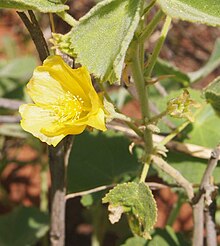| Abutilon otocarpum | |
|---|---|

| |
| Abutilon otocarpum flower | |
|
Scientific classification
| |
| Kingdom: | Plantae |
| Clade: | Tracheophytes |
| Clade: | Angiosperms |
| Clade: | Eudicots |
| Clade: | Rosids |
| Order: | Malvales |
| Family: | Malvaceae |
| Genus: | Abutilon |
| Species: | A. otocarpum
|
| Binomial name | |
| Abutilon otocarpum | |
Abutilon otocarpum, the desert lantern, [1] is a small shrub of the family Malvaceae found in most parts of Australia. [2]
Description
This shrub can grow to 60 cm tall, with flat leaves that alternate up its stem. Leaves of the desert lantern can grow to 1.5 – 6 cm long and are narrow to circular, hairy and toothed. The flowers are yellow, with 5 petals, borne singly on stalks originating at the bases of the leaves, often appearing clustered at the ends of the stems. [3]
The desert lantern differs from dwarf lantern flower ( Abutilon fraseri) and plains lantern-bush ( Abutilon halophilum) in that the petals are about the same length as the calyx, and from velvetleaf ( Abutilon theophrasti) in that the tops of the fruitlets in the fruiting body have very short points. [4]
Cultivation and uses
Abutilon otocarpum grows wild in a range of climates from warm temperate to the tropical zone, and is found particularly in semi-arid areas of the tropics and subtropics. [5] Plants in this genus generally require a position in full sun or part day shade, and a fertile well-drained soil. [6] The desert lantern can be in flower for much of the year.
A fibre was obtained from the stem bark by Aboriginal peoples, including the Kalkatungu, [7] but it is unknown if the plant is still utilized today.[ citation needed]
Habitat
Abutilon otocarpum is found in semi-arid districts; on red sandy soils, sand rises and dunes. It occurs on sandplains and low sandy rises, dunefields, fertile alluvial plains, Mulga-dominated red earth plains, intermittent watercourses and run-on areas, and rocky or gravelly ranges, hills or rises composed of neutral or acidic rocks. [8]
Aboriginal language names
- Alyawarr: akeley-akeley, anteyterrk, arlpart, aylpart
- Anmatyerr: akeley-akeley
- Pintupi Luritja: tatji-tatji
- Pitjantjatjara: tjirin-tjirinpa
- Warlpiri: jinka-jinka, taji-taji[ citation needed]
Ethnobotany
Abutilon otocarpum is a food and water source for the Alyawarr, and a source of firewood and material for toys and spears for the Anmatyerr. Its fruit is a source of food for the Pintupi Luritja and the Pitjantjatjara, and is used in fish-poisons and traps by the Pitjantjatjara and the Warlpiri.[ citation needed]
References
- ^ Muell, F. "Abutilon otocarpum". VICFLORA. Retrieved 6 June 2018.
- ^ "Abutilon otocarpum F.Muell". Atlas of Living Australia. Retrieved 10 May 2018.
- ^ Muell, F. "Abutilon otocarpum". VICFLORA. Retrieved 6 June 2018.
- ^ Cunningham, G; Mulham, W; Milthorpe, P; Leigh, J (2011). Plants of Western New South Wales. CSIRO. pp. 485–486. ISBN 9780643103634.
- ^ "Abutilon otocarpum". PlantNET. Retrieved 6 June 2018.
- ^ Huxley, A (1999). The New RHS Dictionary of Gardening. London: Macmillan. ISBN 0333770188.
- ^ Dilkes-Hall, India Ella; Balme, Jane; O'Connor, Sue; Dotte-Sarout, Emilie (2020). "Archaeobotany of Aboriginal plant foods during the Holocene at Riwi, south central Kimberly, Western Australia" (PDF). Vegetation History and Archaeobotany. 29 (3): 309–325. Bibcode: 2020VegHA..29..309D. doi: 10.1007/s00334-019-00744-3. hdl: 1885/204612.
- ^ "Abutilon otocarpum". Flora NT. Retrieved 7 June 2018.